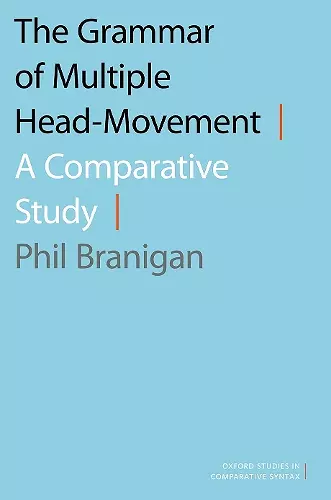The Grammar of Multiple Head-Movement
A Comparative Study
Format:Hardback
Publisher:Oxford University Press Inc
Published:4th May '23
Currently unavailable, and unfortunately no date known when it will be back

Head-movement has played a central role in morpho-syntactic theory, but its nature has remained unclear. While it is widely accepted that the main grammatical constraint controlling head-movement is the Head Movement Constraint (HMC), this constraint is flouted in many of the linguistic structures examined in this book. More specifically, the strictures of the HMC turn out to be sometimes inactive for specific grammars allowing multiple head-movement to take place in particular syntactic contexts. In The Grammar of Multiple Head-Movement, Phil Branigan shows that multiple head-movement is far from rare, forming a part of the grammar in Finnish, in English, in Perenakan Javanese, in northern Norwegian and Swedish dialects, and generally in the Slavic and Algonquian language families. Basing his analysis on a new model of the grammatical parameters which control word formation in the human brain, Branigan shows how careful attention to the contexts in which multiple head-movement takes place allows new generalizations to be identified. And these, in turn, allow a new model to be formulated of how head-movement fits into the overall architecture of grammatical computation. Through careful comparative study, Branigan not only provides a better understanding of head-movement, but also provides new opportunities to address larger questions concerning the architecture of the grammatical system and the theory of linguistic parameters. A new account of how complex words are formed in languages as different as Russian or Innu-aimun, as well as in English, this study deepens our understanding of how languages vary and of the mental computational system of human grammars.
In this work, Branigan offers a novel analysis of polysynthesis which is both empirically and theoretically very rich in consequences. The analysis also makes novel use of the concept of a 'macroparameter', thereby further enriching our knowledge of both comparative and diachronic syntax. * Ian Roberts, Professor of Linguistics, University of Cambridge *
This is an impressive work that focuses on the puzzles that head-movement poses for the current syntactic theory. It proposes an extremely interesting new approach to head-movement that also accommodates multiple head-movement which has a number of important broader theoretical consequences and sets new grounds for investigating crosslinguistic variation in the relevant domain. It should be a starting point for any future investigations of head-movement as well as the case studies of particular languages and phenomena examined in this thought-provoking work. * %Zeljko Bošković, Professor of Linguistics, University of Connecticut *
Decades of investigation into the mappings between sentence structure to word structure in the languages of the world have taught us enough to see that this relation is surely law-governed. But what are those laws exactly? Alongside some singular successes in specific domains, we have also been left with numerous apparent mismatches and bracketing paradoxes-some of which have puzzled the field for years. At one stroke, Branigan has solved most of them with a proposal that has the property that all great ideas have: once you see it, you can't understand why no one figured this out earlier. At its heart is the idea that the multiple movement to a single stem morpheme exist, and mirrors multiple phrasal movement in the structures it produces. The idea is tested on some of the most difficult problems in Slavic and Algonquian syntax and shown to solve classic problems. A truly impressive and original piece of work. * David Pesetsky, MIT Department of Linguistics and Philosophy *
ISBN: 9780197677032
Dimensions: 162mm x 242mm x 30mm
Weight: 608g
376 pages